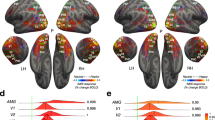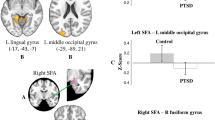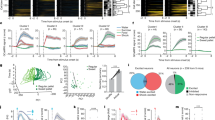Abstract
Functional neuroimaging studies have implicated amygdaloid and basal forebrain regions, including sublenticular extended amygdala (SLEA), in the mediation of aversive emotional responses. However, it is not clear whether SLEA responds to ‘aversiveness’ or to general stimulus salience. We predicted that both pleasant and aversive stimuli would activate this region. Using [15O] water PET, we studied 10 healthy subjects while viewing pleasant, aversive, neutral, and blank images. Each subject underwent eight scans, which were processed and averaged with standard statistical methods. Both positive and negative stimuli activated regions in SLEA. Both positive and negative content activated the visual cortex, relative to neutral content. Aversive stimuli deactivated the left frontal pole, relative to positive and neutral stimuli. These findings demonstrate that both positive and negative emotional content evokes processing in the sublenticular/extended amygdala region, suggesting that this region is involved in general emotional processing, such as detection or attribution of salience.
Similar content being viewed by others
Log in or create a free account to read this content
Gain free access to this article, as well as selected content from this journal and more on nature.com
or
References
Alheid GF, Heimer L (1988). New perspectives in basal forebrain organization of special relevance for neuropsychiatric disorders: the striatopallidal, amygdaloid, and corticopetal components of substantia innominata. Neuroscience 27: 1–39.
Bechara A, Damasio H, Damasio AR (2000). Emotion, decision making and the orbitofrontal cortex. Cereb Cortex 10: 295–307.
Beck CH, Fibiger HC (1995). Conditioned fear-induced changes in behavior and in the expression of the immediate early gene c-fos: with and without diazepam pretreatment. J Neurosci 15: 709–720.
Berridge CW, Mitton E, Clark W, Roth RH (1999). Engagement in a non-escape (displacement) behavior elicits a selective and lateralized suppression of frontal cortical dopaminergic utilization in stress. Synapse 32: 187–197.
Berridge KC (1996). Food reward: brain substrates of wanting and liking. Neurosci Biobehav Rev 20: 1–25.
Berridge KC, Robinson TE (1998). What is the role of dopamine in reward: hedonic impact, reward learning, or incentive salience? Brain Res Brain Res Rev 28: 309–369.
Breiter HC, Etcoff NL, Whalen PJ, Kennedy WA, Rauch SL, Buckner RL et al (1996). Response and habituation of the human amygdala during visual processing of facial expression. Neuron 17: 875–887.
Breiter HC, Rosen BR (1999). Functional magnetic resonance imaging of brain reward circuitry in the human. Ann NY Acad Sci 877: 523–547.
Cherry SR, Woods RP, Mazziotta JC (1993). Improved signal-to-noise in activation studies by exploiting the kinetics of oxygen-15-labeled water. J Cereb Blood Flow Metab 13: S714.
Davidson RJ (1995). Cerebral asymmetry, emotion and affective style. In: Davidson RJ, Mugdahl K (eds). Brain Asymmetry. MIT Press: Cambridge, MA. pp 361–387.
Davidson RJ, Irwin W (1999). The functional neuroanatomy of emotion and affective style. Trends Cogn Sci 3: 11–21.
Davis M (1986). Pharmacological and anatomical analysis of fear conditioning using the fear-potentiated startle paradigm. Behav Neurosci 100: 814–824.
Davis M (1992). The role of the amygdala in conditioned fear. In: Aggleton JP (ed). The Amydala: Neurolbiological Aspects of Emotion, Memory and Mental Dysfunction. Wiley-Liss: New York. pp 255–395.
Davis M, Whalen PJ (2001). The amygdala: vigilance and emotion. Mol Psychiatry 6: 13–34.
de Olmos JS, Heimer L (1999). The concepts of the ventral striatopallidal system and extended amygdala. Ann NY Acad Sci 877: 1–32.
Dolan RJ, Fletcher P, Morris J, Kapur N, Deakin JF, Frith CD (1996). Neural activation during covert processing of positive emotional facial expressions. Neuroimage.
Drevets WC (1998). Functional neuroimaging studies of depression: the anatomy of melancholia. Annu Rev Med 49: 341–361.
Elliott R, Friston KJ, Dolan RJ (2000). Dissociable neural responses in human reward systems. J Neurosci 20: 6159–6165.
Friston KJ, Frith CD, Liddle PF, Frackowiak RS (1991). Comparing functional (PET) images: the assessment of significant change. J Cereb Blood Flow Metab 11: 690–699.
Gallagher M, Schoenbaum G (1999). Functions of the amygdala and related forebrain areas in attention and cognition. Ann NY Acad Sci 877: 397–411.
Ghashghaei HT, Barbas H (2001). Neural interaction between the basal forebrain and functionally distinct prefrontal cortices in the rhesus monkey. Neuroscience 103: 593–614.
Gusnard DA, Akbudak E, Shulman GL, Raichle ME (2001). Medial prefrontal cortex and self-referential mental activity: relation to a default mode of brain function. Proc Natl Acad Sci USA 98: 4259–4264.
Hamann S, Mao H (2002). Positive and negative emotional verbal stimuli elicit activity in the left amygdala. Neuroreport 13: 15–19.
Hamann SB, Ely TD, Grafton ST, Kilts CD (1999). Amygdala activity related to enhanced memory for pleasant and aversive stimuli. Nat Neurosci 2: 289–293.
Haxby JV, Ungerleider LG, Horwitz B, Maisog JM, Rapoport SI, Grady CL (1996). Face encoding and recognition in the human brain. Proc Natl Acad Sci USA 93: 922–927.
Heimer L, Alheid GF, de Olmos JS, Groenewegen HJ, Haber SN, Harlan RE et al (1997a). The accumbens: beyond the core-shell dichotomy. J Neuropsychiatry Clin Neurosci 9: 354–381.
Heimer L, Harlan RE, Alheid GF, Garcia MM, de Olmos J (1997b). Substantia innominata: a notion which impedes clinical-anatomical correlations in neuropsychiatric disorders. Neuroscience 76: 957–1006.
Holland PC, Gallagher M (1999). Amygdala circuitry in attentional and representational processes. Trends Cogn Sci 3: 65–73.
Holmes JE, Egan K (1973). Electrical activity of the cat amygdala during sexual behavior. Physiol Behav 10: 863–867.
Ito TA, Larsen JT, Smith NK, Cacioppo JT (1998). Negative information weighs more heavily on the brain: the negativity bias in evaluative categorizations. J Pers Soc Psychol 75: 887–900.
Kalivas PW, Nakamura M (1999). Neural systems for behavioral activation and reward. Curr Opin Neurobiol 9: 223–227.
Kling AS, Brothers L (1992). The amygdala and social behavior. In: Aggleton JP (ed). The Amygdala: Neurobiological Aspects of Emotion, Memory and Mental Dysfunction. Wiley-Liss: New York. pp 353–377.
Kondo Y, Yamanouchi K (1995). The possible involvement of the nonstrial pathway of the amygdala in neural control of sexual behavior in male rats. Brain Res Bull 38: 37–40.
Koob GF (2000). Neurobiology of addiction. Ann NY Acad Sci 909: 170–185.
Kosslyn SM, Shin LM, Thompson WL, McNally RJ, Rauch SL, Pitman RK et al (1996). Neural effects of visualizing and perceiving aversive stimuli: a PET investigation. Neuroreport 7: 1569–1576.
Lane RD, Fink GR, Chau PM, Dolan RJ (1997a). Neural activation during selective attention to subjective emotional responses. Neuroreport 8: 3969–3972.
Lane RD, Reiman EM, Ahern GL, Schwartz GE, Davidson RJ (1997b). Neuroanatomical correlates of happiness, sadness, and disgust. Am J Psychiatry 154: 926–933.
Lang PJ, Bradley MM, Fitzsimmons JR, Cuthbert BN, Scott JD, Moulder B et al (1998). Emotional arousal and activation of the visual cortex: an fMRI analysis. Psychophysiology 35: 199–210.
LeDoux JE, Cicchetti P, Xagoraris A, Romanski LM (1990). The lateral amygdaloid nucleus: sensory interface of the amygdala in fear conditioning. J Neurosci 10: 1062–1069.
Liberzon I, Taylor SF, Fig LM, Decker LR, Koeppe RA, Minoshima S (2000). Limbic activation and psychophysiologic responses to aversive visual stimuli. Interaction with cognitive task [In Process Citation]. Neuropsychopharmacology 23: 508–516.
Minoshima S, Berger KL, Lee KS, Mintun MA (1992). An automated method for rotational correction and centering of three-dimensional functional brain images. J Nucl Med 33: 1579–1585.
Minoshima S, Koeppe RA, Fessler JA, Mintun MA, Berger KL, Taylor SF et al (1993). Integrated and automated data analysis method for neuronal activation studies using [O-15] water PET Quantification of brain function, tracer kinetics and image analysis in brain PET. Elsevier: Akita. pp 409–415.
Minoshima S, Koeppe RA, Frey KA, Kuhl DE (1994). Anatomic standardization: linear scaling and nonlinear warping of functional brain images. J Nucl Med 35: 1528–1537.
Morris JS, Friston KJ, Dolan RJ (1997). Neural responses to salient visual stimuli. Proc R Soc London Ser B 264: 769–757.
Murray EA, Gaffan EA, Flint Jr RW (1996). Anterior rhinal cortex and amygdala: dissociation of their contributions to memory and food preference in rhesus monkeys. Behav Neurosci 110: 30–42.
Natale M, Gur RE, Gur RC (1983). Hemispheric asymmetries in processing emotional expressions. Neuropsychologia 21: 555–565.
Paradiso S, Johnson DL, Andreasen NC, O'Leary DS, Watkins GL, Ponto LL et al (1999). Cerebral blood flow changes associated with attribution of emotional valence to pleasant, unpleasant, and neutral visual stimuli in a PET study of normal subjects. Am J Psychiatry 156: 1618–1629.
Phillips ML, Young AW, Senior C, Brammer M, Andrew C, Calder AJ et al (1997). A specific neural substrate for perceiving facial expressions of disgust. Nature 389: 495–498.
Phillips RG, LeDoux JE (1992). Differential contribution of amygdala and hippocampus to cued and contextual fear conditioning. Behav Neurosci 106: 274–285.
Rasia-Filho AA, Londero RG, Achaval M (2000). Functional activities of the amygdala: an overview. J Psychiatry Neurosci 25: 14–23.
Reynolds SM, Berridge CW (2001). Fear and feeding in the nucleus accumbens: shell localization of GABA substrates for defensive behavior and eating behavior. Journal of Neuroscience 21: 3261–3270.
Sackeim HA, Greenberg MS, Weiman AL, Gur RC, Hungerbuhler JP, Geschwind N (1982). Hemispheric asymmetry in the expression of positive and negative emotions. Neurologic evidence. Arch Neurol 39: 210–218.
Schoenbaum G, Chiba AA, Gallagher M (1998). Orbitofrontal cortex and basolateral amygdala encode expected outcomes during learning. Nat Neurosci 1: 155–159.
Spitzer RL, Williams JBW, Gibbon M, First MB (1988). Structured Clinical Interview for DSM-III-R. American Psychiatric Press: Washington DC.
Taylor SF, Liberzon I, Fig LM, Decker LR, Minoshima S, Koeppe RA (1998). The effect of emotional content on visual recognition memory: a PET activation study (In Process Citation). Neuroimage 8: 188–197.
Taylor SF, Liberzon I, Koeppe RA (2000). The effect of graded aversive stimuli on limbic and visual activation. Neuropsychologia 38: 1415–1425.
Taylor SF, Phan KL, Decker LR, Liberzon I (in press). Limbic response to emotionally salient stimuli reduced by rating intensity. Neuroimage.
Teasdale JD, Howard RJ, Cox SG, Ha Y, Brammer MJ, Williams SC et al (1999). Functional MRI study of the cognitive generation of affect. Am J Psychiatry 156: 209–215.
Whalen PJ, Rauch SL, Etcoff NL, McInerney SC, Lee MB, Jenike MA (1998). Masked presentations of emotional facial expressions modulate amygdala activity without explicit knowledge. J Neurosci 18: 411–418.
Worsley KJ, Evans AC, Marrett S, Neelin P (1992). A three-dimensional statistical analysis for CBF activation studies in human brain. J Cereb Blood Flow Metab 12: 900–918.
Zalla T, Koechlin E, Pietrini P, Basso G, Aquino P, Sirigu A et al (2000). Differential amygdala responses to winning and losing: a functional magnetic resonance imaging study in humans. Eur J Neurosci 12: 1764–1770.
Acknowledgements
This work was supported by the Ann Arbor Veterans Administration Medical Center (IL) and National Alliance for Research in Schizophrenia and Depression (SFT) and the National Institute of Mental Health (SFT-K08 MH01258).
Author information
Authors and Affiliations
Corresponding author
Additional information
This work was previously presented at the Human Brain Mapping Society annual meeting, San Antonio, Texas, June 2000.
Rights and permissions
About this article
Cite this article
Liberzon, I., Phan, K., Decker, L. et al. Extended Amygdala and Emotional Salience: A PET Activation Study of Positive and Negative Affect. Neuropsychopharmacol 28, 726–733 (2003). https://doi.org/10.1038/sj.npp.1300113
Received:
Revised:
Accepted:
Published:
Issue date:
DOI: https://doi.org/10.1038/sj.npp.1300113
Keywords
This article is cited by
-
The Predictive Value of Head Circumference Growth during the First Year of Life on Early Child Traits
Scientific Reports (2018)
-
Corticolimbic hyper-response to emotion and glutamatergic function in people with high schizotypy: a multimodal fMRI-MRS study
Translational Psychiatry (2017)
-
Excessive users of violent video games do not show emotional desensitization: an fMRI study
Brain Imaging and Behavior (2017)
-
Anhedonia in the psychosis risk syndrome: associations with social impairment and basal orbitofrontal cortical activity
npj Schizophrenia (2015)
-
Acute Alcohol Effects on Attentional Bias are Mediated by Subcortical Areas Associated with Arousal and Salience Attribution
Neuropsychopharmacology (2013)



